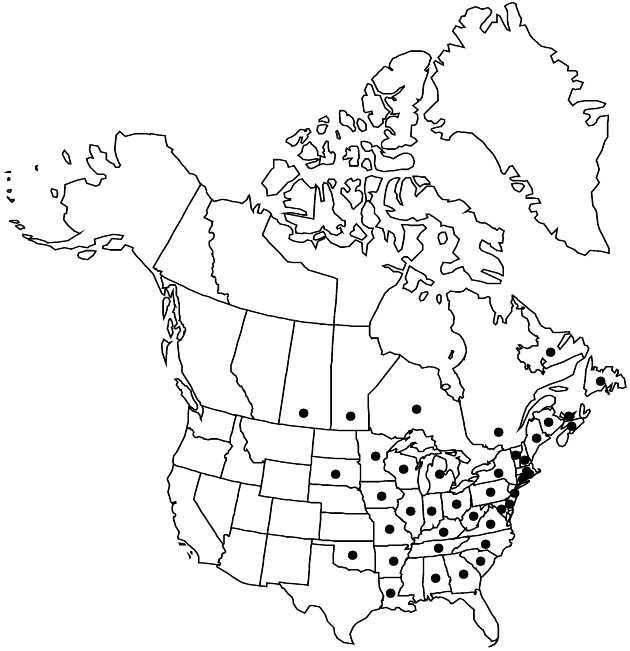Solidago hispida
Sp. Pl. 3: 2063. 1803.
Plants 20–100 cm; caudices branching. Stems 1(–5), erect, simple, glabrous or moderately to densely hispido-villous, sometimes hairs appressed. Leaves: basal and proximal cauline tapering to winged petioles, blades broadly oblanceolate to obovate or elliptic, 35–200 (including petioles) × 15–60 mm, margins serrate or crenate, apices acute, faces sparsely to densely hispido-villous, rarely glabrous; mid and distal cauline sessile, blades elliptic, 15–30 × 5–7 mm, rapidly reduced distally, margins entire. Heads 8–250+ in usually wand-paniculiform arrays of short axillary and terminal racemiform, non-secund clusters, sometimes proximal branches elongated, ascending and bearing short axillary and terminal racemiform clusters. Peduncles 1.5–2.5 mm, hispido-villous to canescent. Involucres campanulate, 4–6 mm. Phyllaries in 3–4 series, appressed, strongly unequal, midribs and tips conspicuously green, margins white, scarious, apices obtuse, glabrous or moderately strigose. Ray florets 6–14; laminae 1.5–4.5 × 0.5–1 mm. Disc florets 6–12; corollas 3–4.5 mm, lobes 0.6–1.2 mm. Cypselae (narrowly obconic) 1–2.5 mm, glabrous; pappi 2.5–4 mm (sometimes distinctly clavate). 2n = 18.
Phenology: Flowering Aug–Oct.
Habitat: Sandy and gravelly soils, disturbed areas, fields, dunes, meadows, open woods, sandy deposits near streams and lakes, rocky outcrops
Elevation: 0–1000+ m
Distribution

Man., N.B., Nfld. and Labr. (Nfld.), N.S., Ont., P.E.I., Que., Sask., Ala., Ark., Conn., Del., Ga., Ill., Ind., Iowa, Ky., La., Maine, Md., Mass., Mich., Minn., Mo., N.H., N.J., N.Y., N.C., Ohio, Okla., Pa., R.I., S.C., S.Dak., Tenn., Vt., Va., W.Va., Wis.
Discussion
Ray floret color can fade with time, both in the field and on dried specimens, making it difficult to distinguish Solidago hispida from S. bicolor, in which it has sometimes been included. The latter tends to have slightly broader phyllaries and more obviously clavate pappus bristles. The two co-occur in some populations but do not appear to form hybrid swarms with a range in ray corolla color. Three varieties have been described on the basis of growth and pubescence features and are sometimes recognized. These may represent only extremes in continua of variation. Variety lanata has densely villous stems and leaves; such plants occur scattered through much of the range of the species. Two glabrous-stemmed varieties have been described; plants of var. tonsa are relatively small and were first described from Newfoundland; var. huronensis includes relatively tall glabrous plants found growing in sand dunes along the shore of Lake Huron in Michigan and Ontario. The latter plants have been treated as var. tonsa but the name is misapplied. Other varietal names are based on minor variations.
Selected References
None.